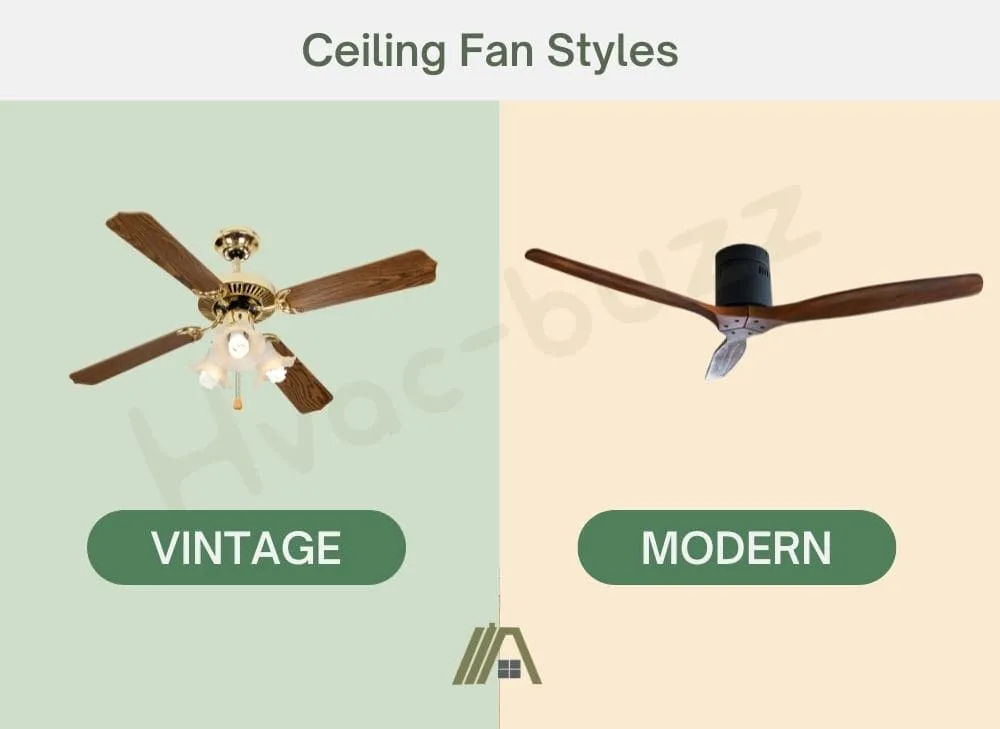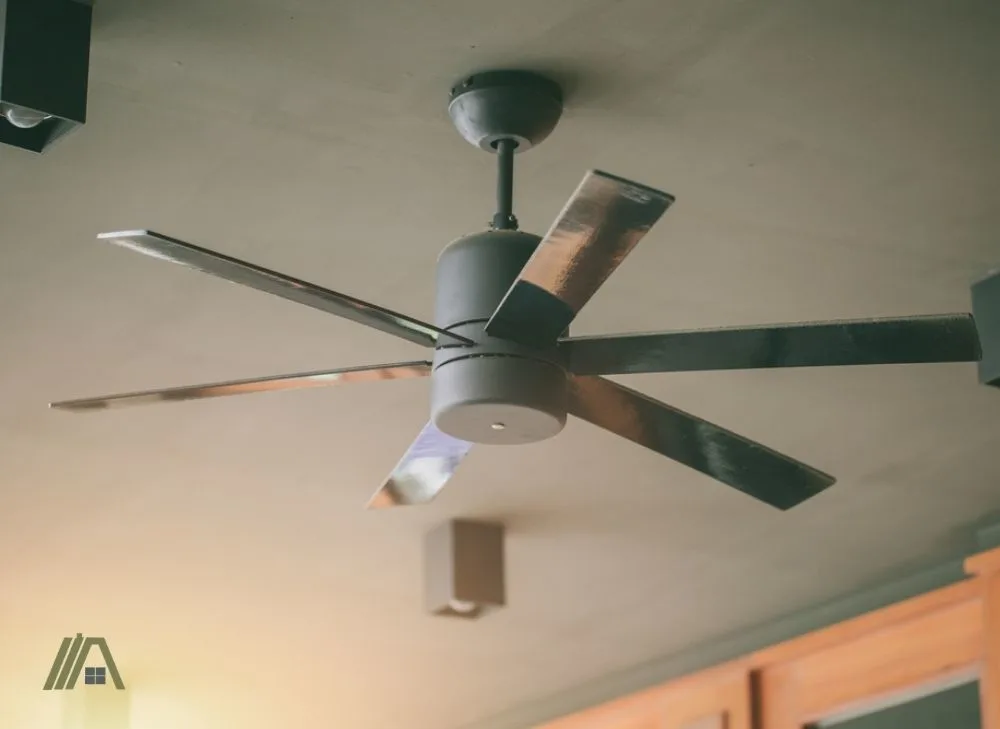Ceiling fans, in one form or another, have been around for over a hundred years. Some people love them while others don’t. Where differences in opinions exist, many theories abound to justify beliefs that, whether true or not, sometimes become urban legends. So, let’s bust some of the more common myths!

Ceiling fan myths:
- They cool a room
- Winter mode warms a room
- They are outdated
- They are costly to run
- They shouldn’t be run with AC
- More blades are better
- Blades decapitate people
- They are dangerous
- Putting them outdoors is pointless
- Fan-rated junction boxes are always required
- Direct attachment to joists is necessary
1. Ceiling Fans Can Cool a Room
Ceiling fans are not able to cool a room down. They do not possess a system that actively removes thermal energy from the air. Ceiling fans simply move the air around the room in a particular way.
This can help to even out the temperature in the room by eliminating pockets of colder or warmer air, but they do not change the overall temperature in the room.
Instead, ceiling fans cool people (and pets). They do this by blowing air over our skin.

When the moving air passes over skin, the naturally-occurring, insulating layer of warm air sitting against the skin is removed. The body will release more heat as a response. This, too, is blown away and our bodies cool down.
This is called wind chill and it means that the cooling mechanism of ceiling fans is entirely dependent on the presence of occupants. Leaving a fan on in an empty room won’t make it colder for you when you enter the room later.
2. Ceiling Fans Are Effective in Winter Mode
Most ceiling fans are fitted with a winter mode setting as standard. This setting allows the fan to turn in the opposite direction during the winter or colder months.
Winter mode reverses the normal airflow in the room, blowing air up against the ceiling instead of blowing air from the top down onto the room’s occupants.
Ceiling fan manufacturers claim that this has the power to make a room feel warmer by displacing the warm air that gathers at the ceiling and distributing it throughout the occupied space.
Now, they certainly can displace and redistribute this warm air. However, there are distinct limitations as to how much of an effect this has on the temperature of the room.
Remember from the previous section that ceiling fans on their own can’t alter the temperature of a room. In winter mode, they are also just eliminating pockets of hotter and colder air and creating a more even distribution of the heat.
The amount of heat that gathers at the ceiling, or rather the disparity of temperatures between the air here and the air lower down in the room is not going to be that great. In addition, the heat from this displaced air is going to be diluted as it spreads through the air below the fan.
What this means is that you are not going to feel the temperature increase significantly.
This does not mean that the reverse function of ceiling fans is useless, though. If you use the ceiling fan in winter mode in conjunction with an external heat source like a radiator, space heater, or wood-burning stove/fireplace, then the fan makes heat distribution much more even, increasing the effectiveness of these heat sources.
3. Ceiling Fans Are Outdated
Ceiling fans have undoubtedly come under pressure regarding relevance since the advent of energy-efficient AC and heating equipment. Despite the challenges, ceiling fans are still found in a significant percentage of homes worldwide.
Ceiling fans are still relevant and have a purpose in the home. Fans fitted with a light serve as a dual-purpose appliance providing light and making the room feel comfortable. The fans remain the most efficient in terms of circulating air around a room, and they’re cheap to run.
Modern design styles are endless and cater to every possible taste and are often a feature in a room that accentuates the room’s décor without getting in the way.

Being attached to the ceiling frees up floor and wall space, and, in terms of cost, ceiling fans are significantly cheaper than a chandelier or designer light.
4. Running the Fan 24/7 Is Expensive
A modern ceiling fan is one of the cheapest appliances to run in a home, even if you run it 24/7 (although this is not necessarily the best idea). When running on the highest speed setting, ceiling fans only consume between 25 to 70 watts of electricity. DC ceiling fans consume the least.
Let’s compare this to the average consumption of common household appliances
| Appliance | Average – Watts | Kilowatt | Cost to run per hour in Cents |
| AC Motor Ceiling Fan | 70 | 0.07 | 0.93 |
| DC Motor Ceiling Fan | 30 | 0.03 | 0.39 |
| Kettle | 1 700 | 1.7 | 22.67 |
| Hair Dryer | 2 200 | 2.2 | 29.28 |
| Washing Machine | 500 | 0.5 | 6.65 |
| Ventless Heat Pump Dryer | 800 | 0.8 | 10.64 |
| Vented Electric Dryer | 3 000 | 3 | 39.93 |
| Ventless Condenser Dryer | 3 000 | 3 | 39.93 |
| Vented Gas Dryer | 1 800 | 1.8 | 23.95 |
| Refrigerator | 350 | 0.35 | 4.65 |
| Electric Oven | 3500 | 3.5 | 46.58 |
| AC – 9000 BTU | 900 | 0.9 | 11.97 |
As seen above, ceiling fans cost less than 1 cent per hour to run. Compare this to the dryers that consume almost 40 times more per hour.
5. AC and Ceiling Fan Should Not Run Together
Many people will tell you that running an AC and ceiling fan together makes both systems less efficient and wastes money. The opposite is true.
Running your ceiling fan and AC simultaneously is an excellent idea as they complement each other perfectly. An AC blows hot or cold air from vents located either high up or low down in a wall or fitted into the ceiling.
The closer you are to the duct, the more pronounced the temperature effect will be. The temperature difference will feel less if you’re far from the vent.
Vents close to floor level tend to cool the lower layers of air in the room, cooling your feet but leaving your upper body parts warmer. This is due to cold air sinking while hot air rises.
Running your ceiling fan while the AC is also on assists the air flowing from the AC to be circulated evenly throughout the room, removing warm and cold pockets of conditioned air.
At the same time, in summer, the air circulation created by the ceiling fan, even when very slight, makes you feel comfortable due to the wind chill effect that we spoke about earlier.
As the ceiling fan and the AC work in unison to make you more comfortable, the AC and the fan can be run at higher temperatures and lower speeds, respectively, resulting in savings on your utility bill.
6. More Blades Means Greater Airflow
A popular misconception is that a ceiling fan with more blades will produce more airflow. The truth is that many factors contribute to a fan’s airflow characteristics.

- Blade configuration: As the number of blades increases, the drag increases, so the motor has to work harder to rotate the blades.
- Shape and size of blades: Fans with 2 to 4 smaller blades produce a more focused column of air as they tend to spin faster. Long blades tend to generate a much gentler, wide-spread breeze.
- Motor type: The type of motor used in the fan directly affects how fast the blades turn and how efficient the fan will be. DC fans produce more torque than AC motors, thus allowing a smaller motor to be used, permitting a compact fan design while still delivering the same CFM as an AC fan.
- Blade pitch: The steeper the blade’s pitch, the more air will be displaced, which means the motor needs to be stronger to maintain its speed due to increased air resistance. Domestic fans utilize a pitch angle of between 12-15°.
More than blade number, pitch and motor size have a greater influence on airflow.
7. People Can Be Decapitated By Fan Blades
A ceiling fan is capable of causing severe injury and even death if a heavy fan falls from a ceiling onto a person. Still, no documented record of decapitation by a ceiling fan exists.
Ceiling fans are mounted at least 7 ft (2.1 m) to 10 ft (3 m) or more from the floor. You’re unlikely to reach the blades unless you’re standing on something.
Furthermore, fan blades are generally lightly constructed and made of wood composites, plastics, or thin metal sheeting that easily bends or breaks. The fan would need a robust, sharp blade driven by a powerful motor to decapitate someone. Neither of which are found on ceiling fans.
Ceiling fans rotate with the blade’s leading edge higher than the trailing edge due to the pitched design. Entering the blades from below will deflect the blade off your head before the leading edge can strike you. In winter mode, the leading edge would be exposed and can potentially cause superficial injury.
8. Ceiling Fans Are Dangerous
Ceiling fans are not inherently dangerous when they’re correctly installed and used. Injuries resulting from ceiling fans are actually rare and when they do happen are mostly minor injuries.
Most injuries involving ceiling fans are caused by accidental contact with the blades. Accidental injuries are mostly caused by not being aware of the fan’s location when, for example, stretching your arms up near a low-hanging fan, standing up onto a chair, etc. Injuries are most commonly inflicted on the head, arms, hands, and fingers.
Falling ceiling fans are extremely rare. Even if they do fall out of the ceiling, they are often caught on the wires, so they don’t fall to the floor or onto people.
When fitting a fan, consider the location and positioning of furniture in the room to ensure children can’t come into contact with the fan when they climb onto or jump on the furniture. Bunk beds and loft beds in bedrooms are particularly risky if the room is fitted with a ceiling fan due to the bed’s height.
Fitting the correct fan for the specific location will go a long way toward preventing injury. A flush mount fan on lower ceilings is a good way of ensuring the fan is high enough from the floor.
Fan maintenance is an essential factor that is often overlooked. Fans require regular cleaning and dusting to ensure that the fan motor breather vents don’t become congested and prevent the fan motor from running hot. Although unlikely to happen, If a spark occurs in an overheated motor, the flammable dust build-up can ignite, setting fire to the house.
9. Outdoor Ceiling Fans Are Pointless
There is a myth that ceiling fans installed in outside areas are as pointless because the space is too large to benefit from the cooling action.
As I say, this is simply a myth. Ceiling fans are great for outdoor areas such as patios, entertainment areas, or your favorite outdoor space. The cooling mechanism acts on people, so if people are around the fan, they will benefit. Outdoor ceiling fans are particularly effective in humid regions.

Outdoor fans are built to withstand harsher climatic conditions and are made to tolerate moisture and resist corrosion. Models fitted with lights serve a dual purpose by providing light and making you comfortable.
Your choice of designs, shapes and size options for outdoor fans is vast, making the fan more than just a fan. The fan is both practical and a feature that will enhance the ambiance of outdoor spaces.
10. All Ceiling Fans Must Use a Fan-Rated Junction Box
It is easy to say that all ceiling fans must be fitted using a fan-rated junction box. I have made similar statements myself. When we get to the specifics, however, this is actually not necessarily true.
A junction box serves a dual purpose by housing the electrical connections between the fan and the electrical supply cables and also serves as a mounting point for the fan mounting bracket when rated for the purpose.
The National Electrical Code (NEC Section 314.27 ( C )) stipulates that only fans weighing 35 lbs and more need to be fitted to a junction box that is specifically rated and labeled for use with ceiling fans by the manufacturer.
Fans weighing less than 35lbs do not require a fan-rated junction box and can be attached to the ceiling using regular junction boxes.
Old plastic junction boxes holding light fixtures such as plastic light fittings are mostly not rated as fan junction boxes unless expressly stated on the box. To be safe, replace the old junction box with a metal fan-rated box.
11. Ceiling Fans Must Be Directly Secured to a Joist
Ceiling fans should be secured to joists. This is what supports their weight. However, you don’t have to screw the fan directly into a joist, which would limit your placement of the appliance.
An off-center ceiling fan in a room doesn’t look good. Ceiling fans are typically located in the middle of a room. So, what happens if this placement falls between two joists? Well, you simply make use of the specially designed ceiling fan brace.
The brace is a metal pole attached between two joists. An adjustable saddle loops around the rod, providing a secure anchoring point for the fan’s junction box. The fan then attaches safely to the junction box.
Braces are available in several different configurations depending on whether you have ceiling access. The braces are length-adjustable and are attached to the joist with screws or through an innovative threaded design that wedges the brace between the joists.
Sources
https://www.electricchoice.com/electricity-prices-by-state/

